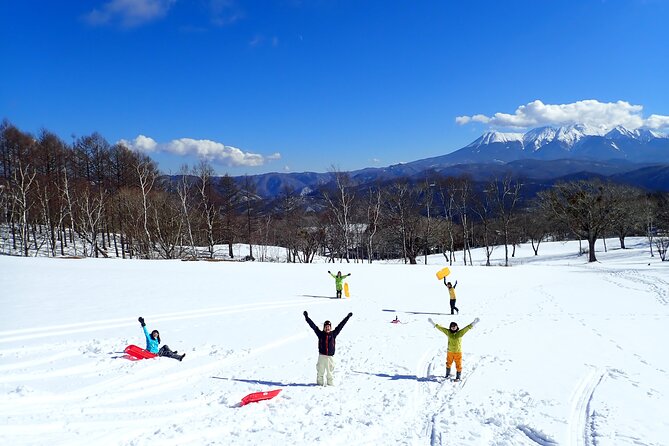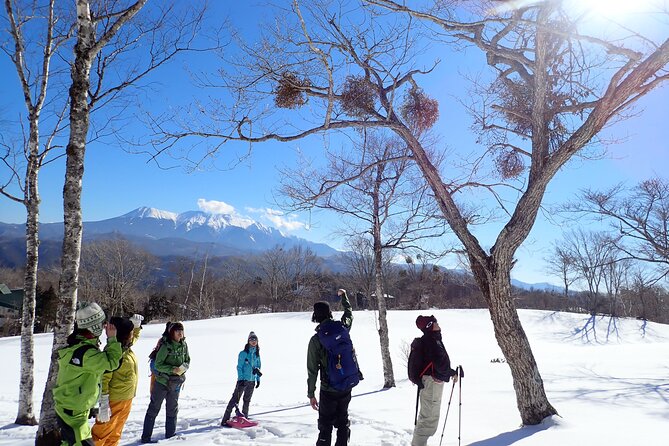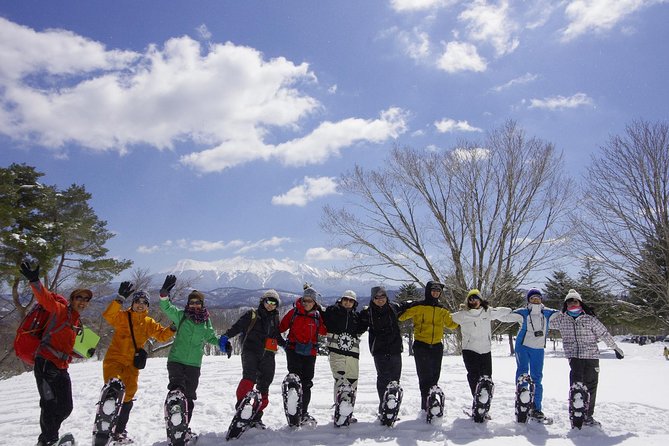Snowshoe Hiking
Have you ever wondered how to navigate snowy terrains effortlessly while enjoying the serene beauty of winter landscapes? Snowshoe hiking might just be the answer you’re looking for.
Discover the practicality and adventure that comes with strapping on a pair of snowshoes and venturing into the snow-covered world. From essential gear to safety tips, this outdoor activity offers a unique way to experience nature during the winter months.
Explore the benefits and possibilities that snowshoe hiking has to offer—it’s a journey waiting to be embraced.
Key Points

- Snowshoe hiking offers a low-impact workout and gentle joint exercise.
- Essential gear includes snowshoes, trekking poles, and insulated clothing.
- Beginners should wear adequate clothing, learn navigation, and inform others of their route.
- Choose trails based on terrain, snow conditions, and group skill level for a safe and enjoyable experience.
Here's some more nearby activities we've reviewed
Benefits of Snowshoe Hiking

Snowshoe hiking offers outdoor enthusiasts a fantastic way to explore snowy landscapes while providing a low-impact workout that’s gentle on joints. This winter fitness activity not only allows individuals to stay active during the colder months but also fosters a deep connection with nature.
As hikers traverse through snow-covered trails, they’ve the opportunity to admire the serene beauty of winter landscapes, listen to the peaceful sounds of nature, and observe wildlife in its natural habitat. The rhythmic crunch of snow underfoot enhances the sensory experience, making each step a mindful moment.
Engaging in snowshoe hiking not only promotes physical well-being but also rejuvenates the mind and soul by immersing individuals in the tranquility of the winter wilderness.
Essential Gear for Snowshoe Hiking
When gearing up for snowshoe hiking adventures, outdoor enthusiasts rely on specific equipment to ensure a safe and enjoyable experience in the winter wilderness. Essential gear for snowshoe hiking includes snowshoes, trekking poles, and appropriate winter clothing. Here is a breakdown of the necessary gear:
| Snowshoe Gear | Winter Clothing |
|---|---|
| Snowshoes | Insulated Jacket |
| Trekking Poles | Waterproof Pants |
| Thermal Base Layers |
Having the right snowshoe gear such as snowshoes for traction and trekking poles for stability is crucial for navigating snowy terrain. Plus, dressing in layers with insulated jackets, waterproof pants, and thermal base layers will keep hikers warm and dry throughout their winter adventure. By being properly equipped, snowshoe hikers can fully enjoy the beauty of the winter landscape while staying comfortable and safe.
Tips for Beginners

For beginners looking to embark on snowshoe hiking adventures, starting with proper preparation and essential tips can significantly enhance their experience in the winter wilderness. Adequate clothing is crucial to stay warm and dry; layers, moisture-wicking materials, and waterproof gear are recommended.
Plus, familiarizing oneself with winter navigation techniques is essential. Beginners should carry a map, compass, or GPS device and learn how to use them effectively in snowy conditions. It’s also important to inform someone of the planned route and expected return time for safety.
Choosing the Right Trail
When selecting a trail for snowshoe hiking, consider the terrain, distance, and level of difficulty to ensure a rewarding and safe outdoor adventure. Understanding the trail selection is crucial not only for the enjoyment of the activity but also for the safety of the group. Evaluating snow conditions and planning the route ahead of time can make a significant difference in the overall experience. Here is a helpful table to guide you in choosing the right trail:
| Terrain Type | Distance (miles) | Difficulty Level |
|---|---|---|
| Forest | 3 | Moderate |
| Mountain Ridge | 5 | Challenging |
| Lake Perimeter | 2 | Easy |
Safety Precautions to Consider
To ensure a safe and enjoyable snowshoe hiking experience, hikers should prioritize dressing in warm, moisture-wicking layers and sturdy waterproof boots. Snowshoe safety and winter adventure go hand in hand, and being prepared is key.
Here are three essential safety precautions to consider:
-
Check Weather Conditions: Stay informed about the weather forecast before heading out. Sudden changes can impact visibility and trail conditions.
-
Carry Essentials: Pack a winter survival kit including a map, compass, first aid supplies, extra food, and water. Be prepared for unexpected situations.
-
Stay Hydrated and Energized: Drink plenty of water and eat high-energy snacks to maintain your stamina throughout the hike.
Environmental Impact Awareness
Taking steps to minimize one’s environmental impact while snowshoe hiking can contribute to the preservation of natural landscapes for future generations to enjoy.
To reduce the carbon footprint, hikers can choose eco-friendly snowshoes made from sustainable materials.
Staying on designated trails helps protect delicate ecosystems, preventing unnecessary damage.
It’s vital to pack out all trash, leaving no trace behind.
Engaging in conservation efforts such as volunteering for trail maintenance or joining local environmental initiatives can further support the protection of these pristine areas.
Health Benefits of Snowshoe Hiking
Minimizing one’s environmental impact while snowshoe hiking not only preserves natural landscapes but also offers a range of health benefits to enthusiasts. Snowshoe hiking is an excellent way to stay active during the winter months and reap the rewards of cold weather benefits.
Here are some health benefits of snowshoe hiking:
-
Winter Fitness: Snowshoe hiking provides a full-body workout, engaging muscles that may not be used as intensely during regular hikes.
-
Cold Weather Benefits: Exercising in cold weather can help boost the immune system, increase calorie burn, and improve cardiovascular health.
-
Mental Well-being: Being surrounded by the winter landscape and breathing fresh, crisp air can have a positive impact on mental health, reducing stress and enhancing overall well-being.
Exploring Different Terrain
Explorers can tackle a variety of terrain while snowshoe hiking, adding excitement and challenge to their outdoor adventures. When venturing out on a winter adventure, snowshoe enthusiasts can explore diverse landscapes, from gentle slopes to steep mountainsides. Mountain exploration is a popular choice for those seeking a more rugged experience, allowing hikers to traverse through snow-covered peaks and valleys. To give you a clearer picture, here is a breakdown of the different terrains you can encounter while snowshoe hiking:
| Terrain Type | Description |
|---|---|
| Forest | Navigate through dense trees and trails. |
| Alpine Meadows | Enjoy wide-open spaces with panoramic views. |
| Rocky Terrain | Challenge yourself with uneven surfaces and rocky paths. |
Here's a few more nearby tours and experiences we have reviewed.
- Full-Day Tour: Immerse in Takayamas History and Temples
- Real Tea Experience in Takayama With Expert Guide
- Takayama, Shirakawago & Kanazawa 3 – Day Tour
- Full Day Private Tour in Hida and Great Limestone Cave
- Takayama/Furukawa Photoshoot by Professional Photographer
- Half-Day Takayama Walking Tour With an English Speaking Guide
Common questions
Are There Any Age Restrictions for Participating in Snowshoe Hiking Activities?
When joining outdoor activities, individuals of all ages can have a safe and enjoyable experience. Family-friendly adventures usually have age-appropriate guidelines and safety precautions in place to ensure everyone’s well-being and comfort.
Can I Bring My Own Snowshoes or Do I Need to Rent Them?
When it comes to snowshoeing activities, participants can typically bring their own snowshoes or rent them on-site. It’s essential to ensure proper fit and maintenance for optimal performance. DIY snowshoe modifications can also enhance the experience.
Is There a Minimum Level of Fitness Required for Snowshoe Hiking?
When considering fitness requirements for activities like snowshoe hiking, it’s crucial to prioritize safety precautions and understand any training programs necessary. Proper gear recommendations can enhance the experience, ensuring participants are adequately prepared.
Are There Any Wildlife Encounters to Be Aware of While Snowshoe Hiking?
Wildlife safety is crucial while hiking. Be aware of surroundings. Respect trail etiquette by not feeding animals. Keep a safe distance. Stay calm if encountering wildlife. Enjoy nature responsibly to ensure safety for all.
How Long Does a Typical Snowshoe Hiking Excursion Last?
A typical hiking excursion duration varies based on the location and difficulty level. The necessary equipment includes sturdy footwear, appropriate clothing, water, and snacks. It is essential to check the weather forecast and plan accordingly for a safe and enjoyable experience.
Here's more of our most recent tour reviews happening neaby
- Private Tour From Takayama to Takayama and Shirakawago
- Ninja Experience in Takayama – Trial Course
- Shuriken Experience in Takayama
- Guided Tour of Hida Folk Village
- Takayama Full Day Tour (Private Guide)
- Shirakawago All Must-Sees Private Chauffeur Tour With a Driver (Takayama Dep.)
- Shirakawago & Takayama Tour Kanazawa DEP: Driver Only, No Guide
- Romantic Tour In Takayama
- Zen Meditation and Higashiyama Temples Walking Tour
- 2-Day Snow Monkey Tour: Nagano to Takayama via Matsumoto
- Tateyama Kurobe Snow Wall! Hida Takayama & Shirakawago
Last Words
To sum it up, snowshoe hiking offers a fantastic way to explore snowy landscapes with ease and excitement. With the right gear and trail selection, beginners can enjoy the beauty of winter while staying safe.
Remember to take precautions, be mindful of the environment, and reap the health benefits of this invigorating activity. So lace up those snowshoes and hit the trails for a memorable winter adventure!